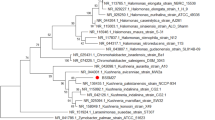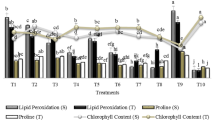Abstract
Halotolerant bacteria associated with Psoralea corylifolia L., a luxuriantly growing annual weed in salinity-affected semi-arid regions of western Maharashtra, India were evaluated for their plant growth-promoting activity in wheat. A total of 79 bacteria associated with different parts viz., root, shoot and nodule endophytes, rhizosphere, rhizoplane, and leaf epiphytes, were isolated and grouped based on their habitat. Twelve bacteria isolated for their potential in plant growth promotion were further selected for in vitro studies. Molecular identification showed the presence of the genera Bacillus, Pantoea, Marinobacterium, Acinetobacter, Enterobacter, Pseudomonas, Rhizobium, and Sinorhizobium (LC027447-53; LC027455; LC027457, LC027459, and LC128410). The phylogenetic studies along with carbon source utilization profiles using the Biolog® indicated the presence of novel species and the in planta studies revealed promising results under salinity stress. Whereas the nodule endophytes had minute plant growth-promoting (PGP) activity, the cell free culture filtrates of these strains enhanced seed germination of wheat (Triticum aestivum L). The maximum vigor index was monitored in isolate Y7 (Enterobacter sp strain NIASMVII). Indole acetic acid (IAA) production by the isolates ranged between 0.22 and 25.58 μg mL−1. This signifies the need of exploration of their individual metabolites for developing next-generation bio-inoculants through co-inoculation with other compatible microbes. This study has potential in utilization of the weed-associated microbiome in terms of alleviation of salinity stress in crop plants.






Similar content being viewed by others
References
Seshadri, S., & Lakshminarasimhan, C. (2007). Population dynamics of P-solubilizers in the rhizosphere of major weed species from a tropical delta soil. In E. Velazquez & C. Rodriguez-Barrueco (Eds.), First international meeting on microbial phosphate solubilization (pp. 281–284). Berlin: Springer.
Kirtikar, K. R. & Basu, B. D. (1990). 2nd ed. Vol. 1. Dehradun, India: International Book Publisher; Indian Medicinal Plants; pp. 536.
Qiao, C. F., Han, Q. B., Song, J. Z., Mo, S. F., Kong, L. D., Kung, H. F., et al. (2007). Chemical fingerprint and quantitative analysis of FructusPsoraleae by HPLC. Journal of Separation Science, 30, 813–818.
Matsuda, H., Sugimoto, S., Morikawa, T., Matsuhira, K., Mizuguchi, E., Nakamura, S., & Yoshikawa, M. (2007). Bioactive constituents from Chinese natural medicines. XX. Inhibitors of antigen-induced degranulation in RBL-2H3 cells from the seeds of Psoralea corylifolia. Chemical and Pharmaceutical Bulletin, 55, 106–10.
Liu, R., Aifeng, L. I., Sun, A., & Kong, L. (2004). Preparative isolation and purification from Psoralea corylifolia by high speed counter current chromatography. Journal of Chromatography, 1057, 225–228.
Guo, J., Weng, X., Wu, H., Li, Q., & Bi, K. (2005). Antioxidants from Chinese medicinal herb—Psoralea corylifolia L. Food Chemistry, 91, 287–92.
Corwin, D. L., & Lesch, S. M. (2005). Apparent soil electrical conductivity measurements in agriculture. Computers and Electronics in Agriculture, 46, 11–43.
Zahra, S. O., Riccardo, T., & Berndt, G. (2004). Plant colonization by pink-pigmented facultative methylotrophic bacteria (PPFMs). FEMS Microbiology Ecology, 47, 319–332.
Supanekar, S. V., & Sorty, A. M. (2013). Siderophoregenic Klebsiella pneumoniaeSUP II from wheat (Triticum aestivum) rhizoplane. Indian Journal Research, 2, 243–45.
Reinhold, B., Hurek, T., Niemann, E. G., & Fendrik, L. (1986). Close association of Azospirillum and diazotrophic rods with different root zones of Kallar grass. Appliedand Environmental Microbiology, 52, 520.
Reinhold, B., Hurek, T., Fendrik, I., Pot, B., Gillis, M., Kersters, K., Thielemans, S., & de Ley, J. (1987). Azospirillumhalopraeferens sp. nov., a nitrogen fixing organism associated with roots of Kallar grass (Leptochloafusca (L.) Kunth)). lnternational Journal of Systematic Bacteriology, 37, 43.
Schwyn, B., & Neilands, J. B. (1987). Universal chemical assay for the detection and determination of siderophores. AnalyticalBiochemistry, 160, 47–56.
Nautiyal, C. S. (1999). An efficient microbiological growth medium for screening phosphate solubilizing microorganisms. FEMS Microbiology Letters, 170, 265–270.
Ehmann, A. (1977). The Van Urk-Salkowski reagent-a sensitive and specific chromogenic reagent for silica gel thin-layer chromatographic detection and identification of indole derivatives. Journal of Chromatography, 132, 267–276.
Tamura, K., Stecher, G., Peterson, D., Filipski, A., & Kumar, S. (2013). MEGA6: molecular evolutionary genetics analysis version 6.0. Molecular Biology and Evolution, 30, 2725–2729.
Sauer, D. B., & Burroughs, R. (1986). Disinfection of seed surfaces with sodium hypochlorite. Phytopathology, 76, 745–749.
Sah, P., Agrawal, D., & Garg, S. P. (2006). Isolation and identification of furocoumarins from the seeds of Psoralea corylifolia L. Indian Journal of Pharmaceutical Science, 68, 768–71.
Prabha, C., Maheshwari, D. K., & Bajpai, V. K. (2013). Diverse role of fast growing rhizobia in growth promotion and enhancement of psoralen content in Psoralea corylifolia L. Pharmacognosy Magazine, 9, S57–S65.
Barak, M., & Ori, L. (2007). The effect of pH on the kinetics of spontaneous Fe (II) oxidation by O2 in aqueous solution—basic principles and a simple heuristic description. Chemosphere, 68, 2080–2084.
Sorty, A. M., & Shaikh, N. R. (2015). Novel co-enrichment method for isolation of magnetotactic bacteria. Journal of Basic Microbiology, 55, 520–526.
Gascoyne, D. J., Connor, J. A., & Bull, A. T. (1991). Isolation of bacteria producing siderophores under alkaline conditions. Applied Microbiology and Biotechnology, 36, 130–135.
Supanekar, S., Sorty, A., & Raut, A. (2013). Study of catechol siderophore from a newly isolated Azotobacter sp. SUP-III for its antimicrobial activity. Journal of Microbiology Biotechnology and Food Science, 3, 270–73.
Wang, Y. C., Wang, F., Hou, B. C., Wang, E. T., Chen, W. F., Sui, X. H., Chen, W. X., Li, Y., & Zhan, Y. B. (2013). Proposal of Ensiferpsoraleae sp. nov., Ensifersesbaniae sp. nov., Ensifermorelense comb. nov.andEnsiferamericanum comb. Nov. Systematic and Applied Microbiology, 36, 467–473.
Naz, I., Bano, A., & Ul Hassan, T. (2009). Isolation of phytohormones producing plant growth promoting rhizobacteria from weeds growing in Khewra salt range, Pakistan and their implication in providing salt tolerance to Glycine max. L. African Journal of Biotechnology, 8, 5762–5766.
Nelson, E. B. (2004). Microbial dynamics and interactions in the spermosphere. Annuual Review of Phytopathology, 42, 271–309.
Sutee, C., Chaum, S., & Sompornpailin, K. (2009). Differential accumulations of proline and flavonoids in indica rice varieties against salinity. Pakistan Journal of Botany, 41, 2497–2506.
Ortíz Castro, R., Contreras Cornejo, H. A., Macías Rodríguez, L., & LópezBucio, J. (2009). The role of microbial signals in plant growth and development. Plant Signaling and Behavior, 4, 701–712.
Badri, D. V., & Vivanco, J. M. (2009). Regulation and function of root exudates. Plant, Cell and Environment, 32, 666–681.
Bais, H. P., Park, S. W., Weir, T. L., Callaway, R. M., & Vivanco, J. M. (2004). How plants communicate using the underground information superhighway? Trends in Plant Science, 9, 26–32.
Castro, S. S., Herschkovitz, Y., Okon, Y., & Jurkevitch, E. (2007). Effects of inoculation with plant growth-promoting Rhizobacteria on resident rhizosphere microorganisms. FEMS Microbiology Letters, 276, 1–11.
Shih-Yung, H. (2010). IAA production by Streptomyces scabies and its role in plant microbe interaction. Masters thesis, Cornell University.
Nakbanpote, W., Panitlurtumpai, N., Sangdee, A., Sakulpone, N., Sirisom, P., & Pimthong, A. (2014). Salt-tolerant and plant growth-promoting bacteria isolated from Zn/Cd contaminated soil: identification and effect on rice under saline conditions. Journal of Plant Interactions, 9, 379–387.
Liu, Y., Shi, Z., Yao, L., Yue, H., Li, H., & Li, C. (2013). Effect of IAA produced by Klebsiellaoxytoca Rs-5 on cotton growth under salt stress. Journal of General and Applied Microbiology, 59, 59–65.
Fatima, Z., Saleemi, M., Zia, M., Sultan, T., Aslam, M., & Riaz-ur-Rehman Chaudhary, M. F. (2009). Antifungal activity of plant growth-promoting rhizobacteria isolates against Rhizoctoniasolani in wheat. African Journal of Biotechnology, 8, 219–225.
Wahyudi, A. T., Astuti, R. P., Widyawati, A., Meryandini, A., & Nawangsih, A. A. (2011). Characterization of Bacillus sp. strains isolated from rhizosphere of soybean plants for their use as potential plant growth for promoting Rhizobacteria. Journal of Microbiology and Antimicrobials, 3, 34–40.
Cuartero, J., & Fernandez-Munoz, R. (1999). Tomato and salinity. Scientia Horticulturae, 78, 83–125.
Popko, J., Hänsch, R., Mendel, R., Polle, A., & Teichmann, T. (2010). The role of abscisic acid and auxin in the response of poplar to abiotic stress. Plant Biology, 12, 242–258.
Rashotte, A. M., Brady, S. R., Reed, R. C., Ante, S. J., & Muday, G. K. (2000). Basipetal auxin transport is required for gravitropism in root of Arabidopsis. Plant Physiology, 122, 481–490.
Hentrich, M., Boettcher, C., & Duchting, P. (2013). ’The jasmonic acid signaling pathway is linked to auxin homeostasis through the modulation of YUCCA8 and YUCCA9gene expression’. Plant Journal, 74, 626–637.
Fu, X., & Harberd, N. P. (2003). Auxin promotes Arabidopsis root growth by modulating gibberellin response. Nature, 421, 740–743.
Liu, P. P., Montgomery, T. A., Fahlgren, N., Kasschau, K. D., Nonogaki, H., & Carrington, J. C. (2007). Repression of AUXIN RESPONSE FACTOR10 by microRNA160 is critical for seed germination and post-germination stages. Plant Journal, 52, 133–146.
Acknowledgements
Financial assistance from Indian Council of Agricultural Research (ICAR), Govt. of India under Application of Microorganisms in Agriculture and Allied Sectors (AMAAS) scheme is gratefully acknowledged.
Author information
Authors and Affiliations
Corresponding author
Ethics declarations
Conflict of Interest
The authors declare that they have no conflict of interest.
Additional information
Highlights
Weed, Psoralea corylifolia L., growing in salinity-affected semi-arid regions, was explored for its associated plant growth-promoting bacteria.
The isolates exhibited potent plant growth-promoting properties in vitro. Culture filtrates containing metabolites significantly promoted seed germination in wheat under high salt environment.
This study has potential in exploitation of weed-associated microbes for development of salt stress resilient bio-inoculant in crop plants
Electronic supplementary material
Below is the link to the electronic supplementary material.
ESM. 1
(DOCX 236 kb)
Rights and permissions
About this article
Cite this article
Sorty, A.M., Meena, K.K., Choudhary, K. et al. Effect of Plant Growth Promoting Bacteria Associated with Halophytic Weed (Psoralea corylifolia L) on Germination and Seedling Growth of Wheat Under Saline Conditions. Appl Biochem Biotechnol 180, 872–882 (2016). https://doi.org/10.1007/s12010-016-2139-z
Received:
Accepted:
Published:
Issue Date:
DOI: https://doi.org/10.1007/s12010-016-2139-z




